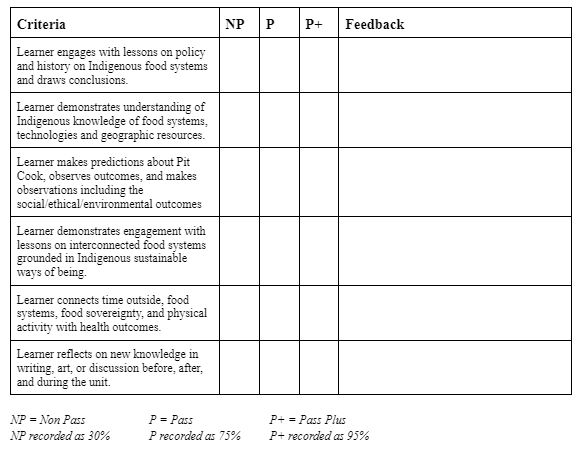
Explanation of Rubric
The above rubric is a variation on a single point rubric. Each of these outcomes corresponds with one or two curriculum outcomes in one subject area covered by the unit (specifically social studies, science, and physical education in this case). Students may demonstrate they have met the outcome in any way at any point throughout the unit (class discussion, quiz games, reflection notebook, experiential pit cook, or special project all being options). Each student will begin in the non pass column – if they do not demonstrate that they’ve met the outcome by the end of the unit they will remain there and the grade entered to the grade book will be a 30% (it is not a zero because a zero grade disproportionately impacts the overall average and fails to recognize the presence of any learning). Should the student demonstrate that they’ve met the outcome at any point in the term they receive a P and this translates in the grade book to a 75%. If over the course of the unit they demonstrate that they understand beyond the required standard described the student has a 95% recorded in the grade book for that outcome. Students have many opportunities in many formats to demonstrate competency, and may choose to request to complete a special assignment, presentation, 1 to 1 discussion, etc. if they’d like to try to improve on a NP or P before the end of term.
This approach to assessment is intended to allow grades to reflect competency, not compliance or memorization. The outcomes reflect curriculum outcomes but also consistently center reflection and learning skills. In offering multiple avenues for demonstration of competence with a variety of formats students are able to engage their strategic network (how we show what we know) in the way that their brain is best equipped to succeed with, creating an engagement of universal design in the assessment process. Additionally, this approach allows them to gain experience and practice with a variety of assessment formats (quizzes, projects, authentic assessment) without the pressure of averaging of assessments. In taking this approach the student learns more about how to approach various assessment styles but their final grade ultimately demonstrates their overall competency, not their ability to succeed at a variety of assessments.
Leave a Reply